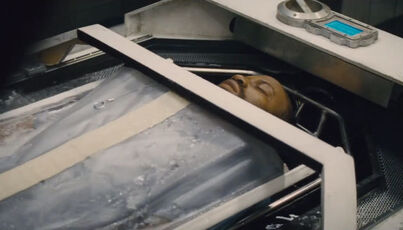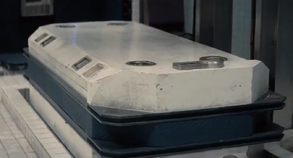(I added a picture of a hypersleep chamber on Endurance) Tag: Visual edit |
Tag: Visual edit |
||
| Line 7: | Line 7: | ||
[[File:Drawing (3).png|thumb|293x293px|A hypersleep chamber on Endurance]] |
[[File:Drawing (3).png|thumb|293x293px|A hypersleep chamber on Endurance]] |
||
| − | It is currently unknown how the pods keep their human sleepers alive. |
+ | It is currently unknown how the pods keep their human sleepers alive. The type of suspended animation, whether extreme hibernation or cryogenic sleep is not specified. If the sleeper were deeply cooled in a form of cryogenic sleep, bodily functions slow or halt altogether, removing the need for oxygen and other consumables. The problem with deep cryogenic hibernation is that water molecules in the body would freeze, crystalize, and puncture cell walls, resulting in the death of the sleeper inside. Sugary "cryo preservative" substances used by certain species of frogs and fish eliminate crystal growth, thereby preserving the organism until conditions are favorable for reanimation. |
If the sleeper is placed in a form of extreme hibernation, where the body's biological process are slowed but not completely halted, the sleeper would need a small supply of oxygen and would still burn calories, likely requiring an intravenous supply of nutrients. Though no IV was required inside the pod, Dr. Mann was provided an IV pack after being awoken from hypersleep. Though the crew were shown to have taken pills before entering their pods. It is possible that the pills may provide nutrients, or chemicals used to preserve the body while "sleeping." |
If the sleeper is placed in a form of extreme hibernation, where the body's biological process are slowed but not completely halted, the sleeper would need a small supply of oxygen and would still burn calories, likely requiring an intravenous supply of nutrients. Though no IV was required inside the pod, Dr. Mann was provided an IV pack after being awoken from hypersleep. Though the crew were shown to have taken pills before entering their pods. It is possible that the pills may provide nutrients, or chemicals used to preserve the body while "sleeping." |
||
Revision as of 19:35, 22 June 2020

Hypersleep Pods (a.k.a. "The Long Nap") are used to slow the aging process of the human body so that astronauts do not incur excessive senescence and not overly consume limited supplies while on their missions. Not much is known about how they function since the technology is never directly mentioned or explained. The pods appear to be large coffin-like boxes with an unknown amount of shielding/ insulation between the outer shell and the inner shell, where the person lies.
The inside is filled with a small amount of water like liquid (it can just be water) that appears to be heated by an unknown power source, as evidenced by the steam that it gives off when opened. A person lies down on a metal skeleton bed or frame that rises up improve entering and egress. Afterwards, the bed is lowered and the small amount of 'water' rises to be slightly above the persons face. Next, a plastic bag is pulled over the person, completely enveloping their body and sealing the air and 'water' inside. Water (if the liquid is water) is a natural radiation shield and is used to protect the occupant from cosmic rays and solar radiation. The water may also be part of the reanimation procedure, which is warmed raise the occupant's body temperature to active levels.
After this, the metal lid automatically closes the pod, completing the seal and presumably activating the hypersleep function at the same time. Hypersleep pods, as long as they have power, are capable of preserving its occupants and reanimating them even after a period of 35 years. But the upper limit of the technology, how long the pods can reanimate a body without serious mental and physical side-effects is currently unknown. Astronauts may either choose to set a "waking date" on their pod or not - keeping them in suspended animation until rescue or until its power source is exhausted.
Speculation

A hypersleep chamber on Endurance
It is currently unknown how the pods keep their human sleepers alive. The type of suspended animation, whether extreme hibernation or cryogenic sleep is not specified. If the sleeper were deeply cooled in a form of cryogenic sleep, bodily functions slow or halt altogether, removing the need for oxygen and other consumables. The problem with deep cryogenic hibernation is that water molecules in the body would freeze, crystalize, and puncture cell walls, resulting in the death of the sleeper inside. Sugary "cryo preservative" substances used by certain species of frogs and fish eliminate crystal growth, thereby preserving the organism until conditions are favorable for reanimation.
If the sleeper is placed in a form of extreme hibernation, where the body's biological process are slowed but not completely halted, the sleeper would need a small supply of oxygen and would still burn calories, likely requiring an intravenous supply of nutrients. Though no IV was required inside the pod, Dr. Mann was provided an IV pack after being awoken from hypersleep. Though the crew were shown to have taken pills before entering their pods. It is possible that the pills may provide nutrients, or chemicals used to preserve the body while "sleeping."
It is understood that Dr. Mann was likely in hypersleep for about 35 years. He mentioned that he did not set a "waking date" on his pod and remarked to the crew of the Endurance, "you've literally raised me from the dead." This may be taken as a clue to the type of suspended animation used, which may likely by form of cryosleep - which would cool the body until biological processes come to a near stop - a fine line between life and death.
It is uncertain what would happen if a hypersleep pod would lose power when someone is "sleeping" inside. Without power, the pod would be unable to cool the body, and the occupant might slowly wake up, and find him or herself trapped inside with a limited amount of air. An emergency opening switch would be required for that scenario. It is also likely that the hypersleep pods can be programmed to euthanize the sleeper before its power source is exhausted if desired.